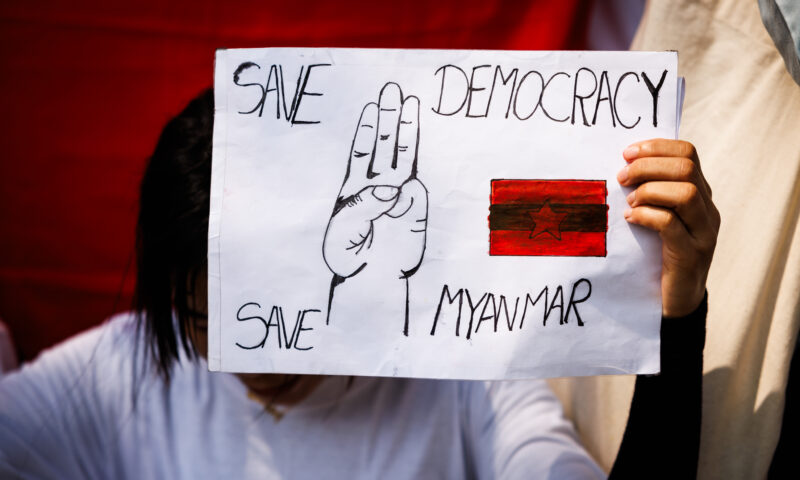Latest News
‘There’s Just No Hiding’: Inside the Self-Defense Class for Landlords
After suing to end eviction protections, an L.A. property owners association prepares for the day tenants attack.

“If you google tenant-landlord murder, you’ll see,” Carrie Rios says.
The former traffic cop pushes her tortoiseshell glasses up her nose and surveys her class of property managers and landlords, who have so far failed to match her pep at 9 in the morning. The poster behind her commemorates a 1948 campaign against rent control: Freedom is everybody’s business, it reads.
Join our email list to get the stories that mainstream news is overlooking.
Sign up for Capital & Main’s newsletter.
“So many cases!” she says, grinning and shaking her head. “That’s why this class is so important.”
On a gray February day at the offices of the Apartment Association of Greater Los Angeles (AAGLA), 11 landlords and property managers have enrolled in a two-and-a-hour self-defense class to protect themselves from “irate tenants,” “transients” and the other hazards of life in the private housing business. The course teaches them how to stop life-threatening bleeding, maintain “360 degrees of awareness,” take cover from bullets and disarm shooters.
Founded in 1917, AAGLA is the premier association representing landlords and property managers in Los Angeles. Last year, it hired the Health and Safety Institute to teach its AVERT (Active Violence Emergency Response Training) self-defense course, because “[a]s landlords and property managers, we can be subject to verbal and/or physical attacks by renters or tenant groups,” the event description explains. “Unfortunately, the media portrays us as ‘evil.’” (It also cites rising violent crime.)
Rios teaches the course with Hans Sievert, a 6’5” lieutenant paramedic who says he is “passionate about bleeding control.” They believe landlords in particular need the training.
“In COVID a lot of people lost their jobs, they lost their family, and the last thing they have is their house,” Rios tells the group. “You’re taking the last thing they have. This is their worst day. I’m not trying to scare you, but you need to be prepared for that.”
“When you go to evict, they’re ready for you,” she adds.
“We’re afraid,” agrees a mom-and-pop landlord who declined to give her name because she was worried about anti-landlord bias. She and her husband tell the group they came to learn how to deal with “homeless people and tenants who get a little crazed” and “tenants who come after you with a video camera.”
* * *
The sessions were an immediate hit when they launched last year, successfully competing for space in a packed AAGLA calendar that also offers estate planning, Q&As with local politicians like County Supervisor Kathryn Barger, and lectures on COVID-19 eviction protections with Dennis Block, the superlawyer once called the Henry Ford of evictions for his “breathtaking” efficiency processing cases. Today’s turnout is paltry compared to that of previous sessions, which sold out at 30 attendees each, Rios explains.
Until Feb. 1, landlords could not evict tenants in the city of Los Angeles who cite COVID-19 as the reason they could not pay rent. The resulting conflicts between tenants and landlords in part inspired AAGLA to host the classes, says executive director Dan Yukelson, who also completed the training. County protections expire March 31. AAGLA sued both the city and the county over their eviction protections, and regularly lobbied to end the so-called moratorium (though L.A. courts continued to process thousands of evictions throughout the pandemic).

Property manager Lupe Leon practices disarming an attacker with AVERT instructor Hans Sievert.
Yukelson agrees that rising rents have raised tensions, too. In Los Angeles County, nearly half of tenants reported that they were unable to pay all of their rent during the pandemic, according to a 2021 UCLA-USC study (the median amount owed was $2,800). USC researchers found that an estimated 73% of renters in the city of Los Angeles were rent burdened in 2019, paying more than a third of their income to their landlords, and 48% of renters are severely rent burdened, paying more than half their incomes to their landlords.
“The only thing that hasn’t been done to us is painting us with horns and a tail,” Yukelson says. “We don’t even say ‘landlord’ anymore, because anything with lord is bad: landlord, drug lord.”
Yukelson says he has no research demonstrating increased violence against landlords. But tenant advocates say that the pandemic heightened conflict, too: L.A.’s Eviction Defense Network says that in 2020, complaints from tenants that their landlords were harassing them increased by 352% over 2019. Executive Director Elena Popp says that landlords, barred from eviction court, resorted to illegal tenant harassment to remove renters. During the pandemic, 911 calls from tenants reporting their landlords had illegally locked them out of their units also spiked, and the calls were concentrated in Black and Latino neighborhoods. By the end of 2022, L.A. County landlords were again filing evictions at pre-pandemic rates.
* * *
After the morning session concludes, property managers Nedra Bloodsaw and Lupe Leon reflect on life “on the front lines” as they fiddle with a pair of Generation VII Combat Application Tourniquets. Bloodsaw says a tenant called her “everything but a child of god” when she tried to throw out the woman’s boyfriend, who was not on her lease. “She cut my tires,” Bloodsaw says.
“When we serve a notice, they start screaming,” Lupe says. “They’re yelling, ‘Why are you evicting me?’”
“The company is safe. They’re far away,” Bloodsaw says. “We have to deliver the hate mail.”
Julian Cuevas, an on-site manager with Roxbury Properties, says violence is a part of the profession “more so than ever.”
When members of the county’s 70,000-strong homeless population break into the building he manages, looking for shelter in vacant units, Cuevas and his wife are sent to remove them. “We always say, sitting in the office, we’re fucked,” he says. “Everyone can see us and everyone knows who we are. Tenants, they’re more bark than bite, but they know where we live, so there’s just no hiding.”

Class participants practice restraining an assailant.
In the first half of the course, the students practice applying tourniquets to life-threatening wounds — lacerations you can bleed out from in three minutes.
“One of the most life-threatening injuries I see is when people punch through plate glass windows, and that might be something you guys deal with in tenant-landlord disputes,” Sievert says as the group murmurs in agreement. “People get heated and they punch out a window. Well, as soon as I get that call, I’m already getting out the tourniquet.”
In well-produced videos, AVERT co-founder Darcy Leutzinger tells the audience to “strike the nose with an open palm” when fighting an assailant. “Push your fingers into the eyes,” the former narcotics officer says, adopting a newscaster’s fluctuating vocal intonations. “Consider scratching — and biting.”
Much of the course focuses on preventing mass shootings, another reason Yukelson says AAGLA started the class.
In the afternoon, four managers from the Lumina Hollywood apartments explain they just foiled a mass shooting in their 22-story building. Another resident manager at a property on Hollywood’s Las Palmas Avenue says a tenant is often publicly intoxicated and has been making suicidal comments. She came to the course, in part, for help.
In the last portion of the training, the group simulates a mass shooting. Sievert pounds on the door with a fake assault rifle as the group hides against the wall. Bloodsaw covers herself with the California flag as Lupe Leon crouches beneath a poster of Howard Jarvis slathering plaster onto a cracking dam marked “Prop. 13,” which is failing to contain a flood labeled “runaway government spending.”
Then Sievert bursts in and they wrench the barrel of his gun from his hands. Cuevas and Jackie Guttierez throw Nerf balls at his face. They cheer and high-five when the big man goes down.
“People want to be Robin Hoods,” Yukelson says. “They want to transfer wealth from a property to someone else. They want free rent. Now they say, ‘Housing is a human right.’ I mean, it’s crazy.”
“Unless the government provides the housing,” he adds. “Can you imagine?”
Copyright 2023 Capital & Main

-

 Locked OutDecember 23, 2025
Locked OutDecember 23, 2025Section 8 Housing Assistance in Jeopardy From Proposed Cuts and Restrictions
-

 Column - State of InequalityDecember 24, 2025
Column - State of InequalityDecember 24, 2025Where Will Gov. Newsom’s Evolution on Health Care Leave Californians?
-

 Latest NewsJanuary 8, 2026
Latest NewsJanuary 8, 2026Why No Charges? Friends, Family of Man Killed by Off-Duty ICE Officer Ask After New Year’s Eve Shooting.
-

 Latest NewsDecember 29, 2025
Latest NewsDecember 29, 2025Editor’s Picks: Capital & Main’s Standout Stories of 2025
-

 Latest NewsDecember 30, 2025
Latest NewsDecember 30, 2025From Fire to ICE: The Year in Video
-

 Column - State of InequalityJanuary 1, 2026
Column - State of InequalityJanuary 1, 2026Still the Golden State?
-

 The SlickJanuary 12, 2026
The SlickJanuary 12, 2026Will an Old Pennsylvania Coal Town Get a Reboot From AI?
-

 Latest NewsJanuary 6, 2026
Latest NewsJanuary 6, 2026In a Time of Extreme Peril, Burmese Journalists Tell Stories From the Shadows

